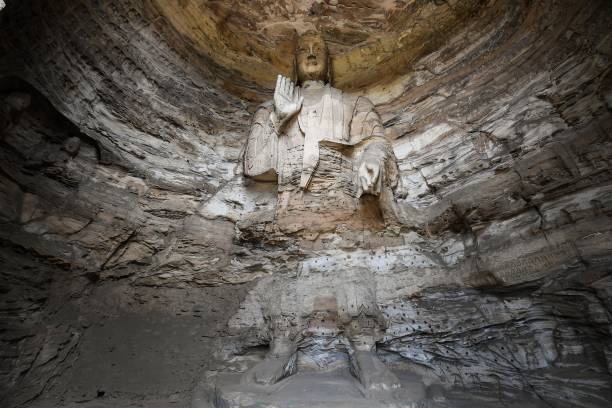Whispers of the Past in the Echoing Halls of Yungang Grottoes

Imagine stepping into a world where ancient stones tell stories of faith and power, where Yungang Grottoes stand as timeless sentinels of China’s spiritual heritage. Located 16 km west of Datong in Shanxi Province, these China Buddhist caves are more than a UNESCO World Heritage Site—they’re a portal to over 1,500 years of history, blending Indian influences with Chinese artistry. Here at jusha.travel, we love sharing tips to make your China journey unforgettable, whether you’re planning a trip to explore these Datong stone wonders or diving into cultural immersions. Join us as we uncover the whispers of the past and the echoes that still resonate in these amazing historical echo tours.
A Stone Canvas of Spiritual Fusion

The Yungang Grottoes, commissioned during the Northern Wei Dynasty (386-534 AD), were born from Emperor Xiaowen’s vision to unify his multiethnic empire under Buddhism, which arrived via the Silk Road. These China Buddhist caves span 18,000 square meters and boast 252 caves, with 51,000 statues carved directly into the sandstone cliffs. What’s remarkable is the fusion of cultures: Indian Gandhara influences mingle with Central Asian motifs and traditional Chinese elements, creating a masterpiece of cross-cultural exchange (UNESCO). You’ll marvel at the ancient China carvings, like the monumental Buddha statues over 20 meters tall in Cave 18. For a deeper dive into China’s rich historical tapestry, check out our guide on Exploring China: History, Culture, and Modernity.
Beyond the scale, the grottoes served as spiritual centers, echoing Buddhist cosmology. The paired caves, such as those designed by Tan Yao, symbolize imperial duality and theological themes. Walk through Cave 12, the “Music Cave,” where celestial musicians and dancers are vividly depicted, offering a sensory experience as old as the stones themselves. If food plays a role in your travels, don’t miss sampling local Shanxi delicacies like noodles or lamb skewers near the site—simple yet flavorful, much like the cave’s enduring influences on East Asian art, from Longmen to Mogao caves (Ancient Origins).
Echoes of Devotion and Cultural Legacy

As you wander the Datong stone wonders, feel the echoes of devotion that once filled these halls. The grottoes were more than royal projects; they were venues for Buddhist worship, meditation, and rituals for monks and laypersons alike. Each carving tells a story of faith, from the detailed reliefs of celestial beings to the larger-than-life Buddhas guarding the caves. The layout itself mirrors Buddhist cosmology, with intentional spatial compositions emphasizing dualities and the path to enlightenment.
This legacy extends far beyond Yungang, influencing subsequent cave temples and symbolizing Buddhism’s enduring impact in China. Emperors used these ancient China carvings to consolidate power, blending religion with statecraft—a practice that echoes through centuries of Chinese history. Nowadays, historical echo tours often include audio guides that bring the past to life, while tech-savvy visitors leverage VR apps to explore restorations. For more on ancient sites like the Terracotta Warriors, our post Why Xi’an’s Terracotta Warriors Are Worth the Hype might inspire your Silk Road adventures.
Modern Experiences Amid Ancient Echoes

Today, Yugang Grottoes draw scholars, artists, and travelers for their artistic milestones and historical authenticity, proving why they were designated UNESCO criteria iii and iv in 2001. To prepare for your visit, consider a self-guided exploration with apps that decipher the iconography. Visitors often combine trips with Datong’s imperial tombs or the neighboring Hanging Monastery for a full day of immersion.
Practical tips for your trip: the best time is spring (March-May) or autumn (September-November) for mild weather. Entry fees are around 120 CNY, and guided historical echo tours cost extra but are worth it for insights. Stay nearby in Datong for accessibility—opt for a hotel with views of Wuzhou Mountain. Pro tip: pair your visit with Shanxi cuisine; try persimmon cakes or dates, which reflect the region’s agricultural heritage.
Preserving the Whispers for Future Generations

Despite 1,500 years of weathering, earthquakes, and repainting (up to twelve times), conservation efforts keep the China Buddhist caves vivid. Rediscovered in Qing times, they now feature rock shelters and minimal-intervention restorations. As a living monument, Yungang reminds us of Buddhism’s power and endurance, covered under UNESCO’s protection (UNESCO).
For travelers interested in broader Chinese history, read our comprehensive guide to Historical Places in China: A Comprehensive Guide to Ancient Sites and Cultural Landmarks. And if traditional customs intrigue you, explore Top 10 Chinese Cultural Traditions Every Traveler Should Know to deepen your understanding.
The Allure of Technology in Ancient Wonders

Interestingly, Yungang’s influence stretches into modern China, where AI and VR enhance visitor experiences without disrupting the original craftsmanship. These tools allow virtual tours of fragile areas, preserving the stones while making history accessible. It’s a beautiful fusion of past and present—much like how China’s tech scene intertwines with its rich culture.
As you plan your China itinerary, consider integrating Yungang with other wonders like the Great Wall or Forbidden City. Our bucket-list guide, What Makes the Great Wall of China a Bucket-List Destination?, and Why Beijing’s Forbidden City Is a Must-See in 2025, offer complementary insights.
A Call to Wander and Reflect

The Yungang Grottoes aren’t just sights—they’re invitations to reflect on faith, culture, and human creativity. Standing among the ancient China carvings and listening to the historical echo tours, you’ll connect with the enduring spirit of these Yungang Grottoes. In a nation of rapid modernization, these China Buddhist caves remind us of roots that still nourish the present.
What whispers will you hear when you visit? Share your thoughts in the comments below, or visit jusha.travel for more China travel inspiration and articles on cultural gems!

